The Asia-Pacific Economic Cooperation (APEC) summit returns to Vietnam this year after an 11-year absence. Although Vietnam has continued its brisk pace of economic development since the 2006 APEC summit in Hanoi, the Southeast Asian country’s regional and global environs have changed dramatically since then. The 2017 APEC summit in Da Nang thus offers Vietnam’s leadership an opportunity to demonstrate their capacity for dealing with such changes.
APEC 2006: Vietnam Sets Course for the World
The end of the Second Indochina War in 1975 resulted in Vietnam’s reunification and was also the start of a relatively long reconstruction. Isolated from the West and at odds with most of its neighbors, Vietnam’s international economic relations depended on its Soviet patron. However, with the fall of the Soviet Union in 1991, Vietnam was forced to liberalize its trade and focus on economic development. That meant pursuing better international relations with both its neighbors in Southeast Asia and the West.
Vietnam thus joined the Association of Southeast Asian Nations (ASEAN) in 1995, allowing Hanoi to benefit from increased trade and investment with its ASEAN neighbors through the ASEAN Free Trade Area (AFTA) and ASEAN’s free trade agreements (FTAs) with China, Japan, South Korea, India, Australia, and New Zealand. Vietnam normalized trade relations with the United States in 2000, which had ended sanctions against Vietnam in 1994. The capstone of Vietnamese economic development efforts was membership in the World Trade Organization (WTO) in early 2007.
The APEC 2006 summit in Hanoi was Vietnam’s coming-out party, its debut on the world economic stage. Improved ties boosted trade, foreign investment, and economic growth. According to the World Bank, Vietnam’s gross domestic product (GDP) more than doubled from $25 billion in 1996 to $66 billion in 2006. Gross national income (GNI) per capita improved from $310 in 1996 to $760 in 2006. However, net annual inflows of foreign direct investment (FDI) remained at or below $2.4 billion during this period.





























